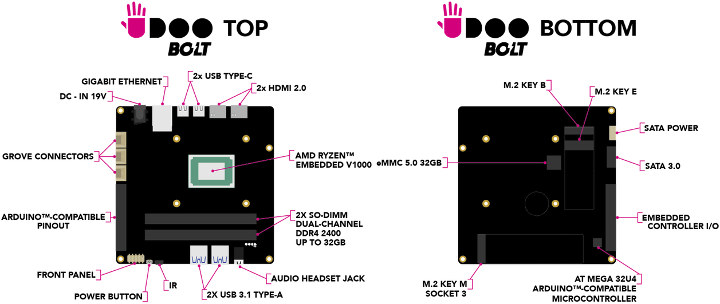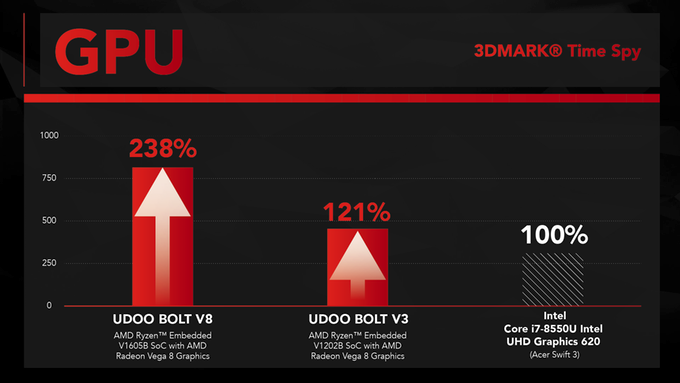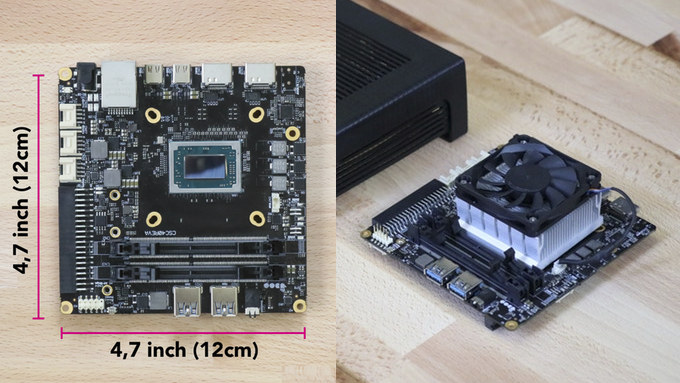While Intel has been outing low cost and low power processors with less than 10W TDP over the years with their Bay Trail, Cherry Trail, Braswell, Apollo Lake, and now Gemini Lake processors, AMD has not really ventured into the low power space, and the latest announcements about 10-12W processors was for their Embedded G-Series J Family, which I have not seen in many products.
More recently, the company introduced Ryzen Embedded V1000 family of processors with 4 to 8 Zen cores, 4K support, 10 GbE interface, and more with a TDP of 12 to 25W for Ryzen Embedded V1202B & V1605B dual / quad core processors.
The latest x86 UDOO board – dubbed UDOO BOLT – will be one of the rare AMD development boards available on the market with pricing starting at $229.
Two versions of the board will be available: UDOO BOLT v3 with Ryzen Embedded V1202B, and UDOO BOLT V8 with Ryzen Embedded V1605B processor. The rest of the specifications are shared:
- SoC
- BOLT V3 – AMD Ryzen Embedded V1202B dual core/quad thread Zen processor @ 2.3 GHz / 3.2 GHz (Boost frequency) with AMD RADEON VEGA 8 graphics (2 GPU CU) with support for DirectX 12, OpenCL, OpenGL, Vulkan, H.265 decode / 8-bit encode, VP9 decode
- BOLT V8 – AMD Ryzen Embedded V1605B quad core/octa thread Zen processor @ 2.0 GHz / 3.6 GHz (Boost frequency) with AMD RADEON VEGA 8 graphics (8 GPU CU) with support for DirectX 12, OpenCL, OpenGL, Vulkan, H.265 decode / 8-bit encode, VP9 decode
- System Memory – 2x SO-DIMM slot for 64-bit DDR4 2400 MT/s memory with ECC support, for up to 32GB RAM
- Storage – 32 GB eMMC 5.0 flash, M.2 Key B 2260 slot for SSD, M.2 Key M 2280 for NVMe SSD, 1x SATA 3.0 connector
- Video Output – 2x HDMI 1.4 / 2.0a output, 2x DisplayPort via USB type C ports
- Audio – 3.5mm audio jack for headphone + microphone
- Connectivity – Gigabit Ethernet (via Realtek RTL81111G), M.2 Key E 2230 socket for optional WiFi + Bluetooth module
- USB – 2x USB 3.0 type A ports, 2x USB 3.1 Gen 1 type C port with DP alternate mode, USB-PD support
- Expansion Headers
- Arduino Leonardo compatible I/Os
- 12x analog inputs
- Up to 23x digital I/Os, including 7 PWM
- 1x UART, 1x I2C, 1x SPI
- 3x Grove connectors with analog input, UART or DIO, I2C or DIO
- Embedded Controller I/Os – 2x UART, 2x I2C, 1x SPI, 1x keyboard scan, 1x fan controller, 10x GPIO
- Arduino Leonardo compatible I/Os
- Misc – Front panel headers, IRDA, fan controller, RTC battery
- Power Supply
- 19V DC USB power barrel or
- USB type C port
- Dimensions – 12 x 12 cm

The company claims the board will run any 64-bit Linux distributions or Windows 10. You won’t have any big compatibility issues like with some Arm boards, but based on my experience with low cost Intel platform, Linux support is not always 100% guaranteed. Maybe it will be different with AMD. You can program the Arduino part directly from the board using Arduino IDE just like most other UDOO boards.
 One of the main benefit of such AMD SoC over Intel competitors is the much improved graphics performance of Radeon Vega 8 Graphics over Intel UHD graphics as shown above especially for the V1605B SKU.
One of the main benefit of such AMD SoC over Intel competitors is the much improved graphics performance of Radeon Vega 8 Graphics over Intel UHD graphics as shown above especially for the V1605B SKU.
UDOO BOLT does deliver much better performance than the development board / single board computer I normally cover here, but it should come at the cost over higher power consumption with a 12W-25W TDP processor. It might be interesting to compare it to something like NVIDIA Jetson TX2 devkit.
The company has just launched the boards on Kickstarter, and it’s been quite popular so far with close to $200,000 raised easily surpassing their $100,000 targets . Rewards start at $229 for UDOO BOLT V3 with heatsink and fan, but not RAM nor PSU, so if you want a complete system, you may consider the “EARLY BIRD UDOO BOLT V3 + Kit 4GB” rewards for $298 with 4GB DDR4, and a 19V/65W PSU. UDOO BOLT V8 rewards start at $309 for the bare model, and go up to $564 for a kit with 16GB RAM, an Intel M.2 WiFi AC + Bluetooth 4.0 module, a 19V power supply, HDMI and SATA cables, and a metal case. Shipping adds $19, and delivery is planned for December 2018.
Thanks to Nobe for the tip.

Jean-Luc started CNX Software in 2010 as a part-time endeavor, before quitting his job as a software engineering manager, and starting to write daily news, and reviews full time later in 2011.
Support CNX Software! Donate via cryptocurrencies, become a Patron on Patreon, or purchase goods on Amazon or Aliexpress





